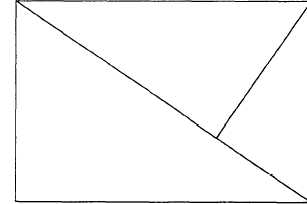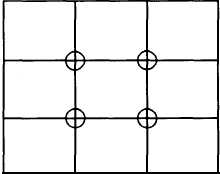Figure 5-5.–Principle of thirds.
Figure 5-6.–Dynamic symmetry.
main object of the photograph should probably be kept
out of the picture; for instance, a photograph showing a
person standing at some distance in front of a building
may leave the observer wondering whether the person
or the building is the primary subject. When people are
included in a scene for comparative size of objects or
just for atmosphere, keep them from looking directly at
the camera. When people look at the camera and
therefore at the viewer of the picture, the viewer tends
to return their gaze by looking directly back into their
eyes. When they are not the intended point of interest,
we miss the statement and purpose of the picture. When
people are subordinate elements within the picture and
they are looking in a direction other than at the camera,
the viewer’s attention is directed from the people to what
they are looking at, which should be the center of
interest; for example, when people are grouped around
a piece of machinery that is the center of interest of the
picture, have them look at the machine, rather than the
camera.
SUBJECT PLACEMENT
Sometimes good composition is obtained by placing
the center of interest in the geometrical center of the
picture; it is generally not a good idea to place it there.
Too frequently it divides the picture into equal halves
and makes the picture uninteresting and difficult to
balance. By dividing the picture area into thirds, both
vertically and horizontally, and locating the center of
interest at one of the intersections of the imaginary lines,
you can usually create a feeling of balance to the
composition (fig. 5-5).
In photographic composition there are two general
guides for determining the best location for the center
of interest. The first is the principle of thirds. The other
is dynamic symmetry. In the principle of thirds, the
intersection of lines that divide the picture area into
thirds are marked by O’s. These intersections are good
locations for the center of interest in most photographs.
Notice we said THE center of interest. Remember, have
only one center of interest to a picture-keep it simple.
The principle of dynamic symmetry is a similar idea. A
good location for the center of interest is found by
drawing or imagining a diagonal line from one corner
to an opposite corner. Then, draw a second line
perpendicular to the first from a third corner (fig. 5-6).
The intersections of the lines are the location for the
center of interest.
SIMPLICITY
Simplicity is the key to most good pictures. The
simpler and more direct a picture is, the clearer and
stronger is the resulting statement. There are several
things to be considered when we discuss simplicity.
First, select a subject that lends itself to a simple
arrangement; for example, instead of photographing an
entire area that would confuse the viewer, frame in on
some important element within the area. Second, select
different viewpoints or camera angles. Move around the
scene or object being photographed. View the scene
through the camera viewfinder. Look at the foreground
and background. Try high and low angles as well as
normal eye-level viewpoints. Evaluate each view and
angle. Only after considering all possibilities should you
take the picture. See beyond and in front of your subject.
Be sure there is nothing in the background to distract the
viewer's attention from the main point of the picture.
Likewise, check to see there is nothing objectional in the
foreground to block the entrance of the human eye into
the picture.
A last point of simplicity-tell only one story. Ensure
there is only enough material in the picture to convey
5-7




